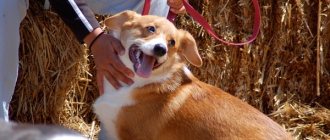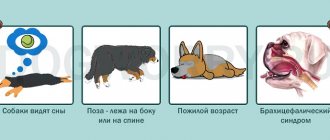Signs of poisoning in a dog
Food poisoning is more often diagnosed in dogs - dangerous substances enter the body through the esophagus. The reason is the use of expired or prohibited products, poor-quality or stale water, medicines, household chemicals, herbs and plants. In case of non-food poisoning, toxins penetrate through the skin or organs of the respiratory system - insect bites, inhalation of harmful fumes.
With any form of poisoning, the dog exhibits inappropriate behavior - it becomes lethargic, drowsy, or very excited, and stops responding to the owner; when such symptoms appear, first aid must be provided to the animal.
Rat poison
The main sign of poisoning by rat poison (brodifacoum, bromadiolone) is frequent nose or mouth bleeding, blood clots are present in the vomit, saliva, and feces. It is difficult for the dog to swallow, body temperature increases, and breathing is heavy.
In case of poisoning with Zookoumarin, Ratside, zinc phosphide, diarrhea and vomiting with blood occurs after 2–4 hours, there is no urination, there is strong thirst, the pulse is weak, breathing is heavy, the pupils are dilated, convulsions and fainting often occur.
Isoniazid
In case of poisoning with Tubazid or Isoniazid, a sharp deficiency of pyridoxine (vitamin B6) occurs in the dog’s body, which negatively affects the functioning of the central nervous system - convulsions appear, confusion and loss of coordination of movement are observed, the animal bumps into objects, staggers, foams at the mouth, convulsions occur, coma may occur. Lethal dose – 50 mg/kg.
Isoniazid is a strong poison for dogs; if you do not provide help within an hour, you will not be able to save your pet.
Food
You can tell that a dog has been poisoned by bad or forbidden food by frequent bouts of vomiting, diarrhea, the stomach is swollen and painful, and the mucous membranes become bluish. In case of severe intoxication, food debris, mucus, gastric juice, and bile are present in the vomit.
Poisoning with xylitol, fresh or dried grapes, and toothpastes in dogs is often observed. Daily salt consumption in a dosage of more than 3–4 g/kg is fatal for a pet; in case of poisoning, disturbances in the functioning of the nervous system occur, signs of severe dehydration are observed, asphyxia develops without proper assistance, and the animal dies.
Dogs should not be constantly fed meat, as protein poisoning will occur; cat food is also contraindicated; it contains a lot of taurine.
List of dangerous foods for dogs:
- onion garlic;
- tomatoes;
- nuts;
- broccoli;
- potato peelings;
- avocado.
Dogs can be poisoned by chocolate because the product contains theobromine, a dangerous alkaloid for animals. When consuming 150 g, severe intoxication develops, and a dose of 250 g is fatal for small dogs and puppies. Signs of chocolate poisoning are shortness of breath, rapid heartbeat, convulsions, muscle twitching, dyspeptic disorders, rumbling in the stomach.
Poisoning. First aid
Used materials from the site https://www.gsdog.ru/vet/poison.html
What the dog was poisoned with can usually only be speculated (except in cases where the dog ate something clearly poisonous in front of the owner)
Very often, dog owners are faced with poisoning from biological products - low-quality food (including expired dry food), carrion that dogs pick up on the street, etc. Poisoning manifests itself as vomiting and abdominal pain, followed by diarrhea (often mixed with blood). In this case, acute infectious diseases, as well as damage to the gastrointestinal tract by foreign objects, should be excluded. If you are sure that the dog has been poisoned, it is necessary to remove the poison from the body as quickly as possible by giving an emetic and performing cleansing enemas. Vomiting can be caused by forcing the dog to swallow a little baking soda, a solution of salt, liquid soap or mustard mixed in water. After providing first aid, be sure to consult a veterinarian.
Among the most common cases of poisoning, one can also name poisoning by rats, which have two main mechanisms of action. In one case, when the poison enters the stomach, a very toxic substance is formed - phosphine; in another case, the poison contains anticoagulant drugs (prevent blood clotting). When poisoned by poisons containing anticoagulants, the dog develops nosebleeds, blood in the stool, and hematomas. Anemia gradually develops, the mucous membranes become pale. The dog must be taken to the clinic as soon as possible to remove the toxin from the body and restore blood properties.
And remember - the main means of preventing poisoning should be considered proper training of the dog, as well as a leash and muzzle for animals that cannot be weaned from the habit of picking up carrion.
The most common substances that cause poisoning in dogs and first aid
(based on materials from the book “The Health of Your Dog” by A. Baranov)
Adrenaline (ephedrine).
Symptoms: dog restlessness, body tremors, shortness of breath. The mucous membranes are pale. The animal's pulse is initially slow, then quickened. Palpitations.
First aid: give the injured dog rest, cover the body and limbs with warm heating pads, and wrap them up. Give papaverine and dibazole orally. Urgent veterinary care.
Silver nitrate (lapis).
Symptoms: the dog’s oral mucosa becomes gray or white; the dog sits hunched over and groans; vomiting of white masses that quickly darken, and diarrhea in which black stool is observed. Convulsions of the body or individual limbs may occur.
Help: give the dog a solution of table salt, prepared at the rate of 1/2 teaspoon of salt per 1 liter of water; You can add small pieces of ice to the saline solution; milk is given abundantly; A cleansing and therapeutic milk enema is given.
Urgent veterinary care.
Aminazine.
Symptoms: the dog is in a state of sleep all the time, sometimes vomits, and convulsions are possible.
First aid: rinse the stomach, give a saline laxative. If the animal is conscious, give it strong warm tea.
Anabasine.
Poisoning in dogs is observed in the summer, during the period of treatment of berry and vegetable crops with preparations containing anabasine. Poisoning occurs in a dog that gets into the plant processing area. The oily liquid adheres well to the dog’s fur and paws. And when the animal begins to clean its coat and paws, poisoning becomes inevitable. Even 1-3 drops that enter its body can cause the death of a medium-sized dog.
Symptoms: the dog is constantly vomiting, she lies down all the time, and does not even try to get up. Palpitations. The tongue, mucous membranes of the lips, and the eyelids are bluish in color. Consciousness quickly darkens, the dog ceases to recognize people close to it, does not respond to nicknames or treats. The death of the animal occurs due to paralysis of the respiratory muscles.
First aid: copious gastric lavage with activated charcoal, then a saline laxative. Urgent assistance from a veterinarian.
Analgin, pyramidon, phenacytin.
Symptoms: the dog is vomiting and lethargic; pupils dilated; breathing is difficult, there may be convulsions; A rash may appear on the skin of the abdomen.
First aid: the dog should be given cold, but not ice water with activated carbon, plenty of milk, strong sweet tea.
Aniline (chemical pencil, etc.)
Symptoms: the dog vomits quickly; she is lethargic; visible skin of the abdomen, mucous membranes are initially pale, then gray-blue; pupils are dilated, breathing is difficult; body temperature drops by 1-2° C; urination is difficult, there is often blood in the urine; in severe cases of poisoning - convulsions.
First aid: you need to take the dog out into the fresh air; give strong cold tea and milk inside; Apply an ice pack or cold compress to your head. Urgent medical care.
Antiparasitic collar.
Recently, many dog owners have used a special collar as a means of repelling skin parasites: fleas, lice, ticks. This anti-parasitic collar, produced in various foreign countries, is impregnated with a toxic substance containing an organophosphorus compound (for example, 2,2 dichlorovinyl dimethyl phosphate).
After wearing an anti-parasitic collar, some dogs experience a picture of poisoning: the dog becomes lethargic, the appetite disappears, drooling and vomiting are observed, and the gait becomes unsteady (wobbly). Also, after 3-7 days, dry or weeping eczema develops on the dog’s neck, where the collar contacts the skin. The animal feels restless and scratches the affected areas.
Required assistance: free the dog from the anti-parasitic collar and consult a veterinarian.
Apomorphine.
An emetic, which is usually administered to stimulate the vomiting center.
Symptoms: the dog constantly vomits, it experiences weakness, due to which it cannot get up.
First aid: give the dog warm milk, give activated charcoal, warm it with heating pads and quickly take it to a veterinary hospital.
Atropine.
(contained in plants of the nightshade family: belladonna, sleeping stupor, henbane, datura).
Atropine is a strong toxic substance that acts on the dog’s nervous system, causing motor and mental agitation, body convulsions, and even visual and auditory hallucinations. Poisoning is most often observed in the summer, when owners take their four-legged friends into the bosom of nature and, trying to compensate for the lack of vitamins, cook jelly and decoctions from the leaves and fruits of these plants.
Symptoms: vomiting; the pupils are sharply dilated; hoarse barking; constant thirst; the skin of the abdomen is reddened. Pulse is frequent. The dog is excited. Body convulsions resembling epilepsy. The death of the animal occurs within 3-12 hours.
First aid: rinse the stomach with water several times, give activated charcoal, laxatives. Drink strong sweet tea and coffee. Urgent medical attention is needed.
Boric acid.
Symptoms: repeated vomiting; body temperature is reduced - 36-37° C; decline in cardiac activity; A rash may appear on the skin of the abdomen.
First aid: the dog is given milk, liquid starch jelly, and burnt magnesia is given.
Veratrine (white hellebore).
Poisoning often occurs when dogs are washed in a hellebore solution to combat fleas and other parasites of the skin and coat.
Symptoms: drooling, thirst, vomiting, diarrhea, there may be convulsions; mucous membranes of the eyes and lips are pale; the breathing process is disrupted.
First aid: inside - tannin solution, strong tea, iodine water (for 1 glass of cool water - 2 drops of iodine tincture).
Gases and vapors.
The greatest danger to dogs are poisonous gases and vapors: chlorine, bromine, iodine, phosgene, chloropicrin, nitrogen oxides, sulfur dioxide, nitric acid, carbon monoxide (carbon monoxide), aniline, nitrobenzene, arsenic hydrogen.
Poisoning of dogs caused by car exhaust fumes also occurs. This happens when dogs are transported long distances in a closed car with a faulty exhaust system. Light gas penetrates through cracks in the floor and, in the absence of proper ventilation of the body, causes poisoning in animals.
Symptoms: lacrimation, salivation, sneezing, paroxysmal cough, vomiting with blood, severe shortness of breath, visible mucous membranes of the eyes and mouth are bluish. The gait is shaky and unsteady.
Required assistance: Remove the affected dog from the atmosphere of toxic fumes as soon as possible. Abundant rinsing of the mucous membranes with a 2% solution of baking soda, prepared at the rate of one teaspoon of soda per glass of water. Take any antitussive medication internally, and artificial respiration if necessary.
Mushrooms are poisonous.
Poisoning occurs when dogs are fed soups made from poisonous mushrooms. Poisonous mushrooms for dogs are: white or pale toadstool, red fly agaric, false gray-yellow honey fungus, false white mushroom. Poisonous mushrooms or their alkaloids have a toxic effect on the cardiovascular system, central nervous system, gastrointestinal tract, liver, kidneys, i.e., on almost all vital organs of the dog.
Symptoms: the dog constantly feels sick, vomits, moans due to abdominal pain, diarrhea is usually bloody; increased thirst; body temperature drops to 36°; the pulse is slow and barely detectable; consciousness in severe conditions is darkened; The dog does not recognize the owner, lies down, does not respond to the name.
First aid: rinse the stomach with water or a pale pink solution of potassium permanganate; introduce activated charcoal into the stomach; give strong sweet tea, coffee with milk, then pour castor oil inside from 1 teaspoon to 100 grams, depending on the weight of the dog; Briefly apply a cold compress, cold water heating pad, or ice pack to your head.
Inkstone.
Symptoms: vomiting, diarrhea (black feces); The dog is moaning due to stomach pain.
Necessary help: give the dog plenty of milk, mucous decoctions, egg whites, table soda solutions at the rate of one teaspoon of soda per glass of water; give a laxative.
Iodine (iodine tincture).
Symptoms: excessive salivation; vomiting brown or blue masses (depending on the starch content of food); diarrhea; the mucous membrane of the oral cavity and tongue are brown and swollen; possible nosebleeds; rash on the stomach, cramps.
First aid: abundant gastric lavage with water, then the dog is given milk, activated carbon, liquid starch paste, mucous decoctions.
Carbolic acid (creolin, lysol, etc.).
Poisoning occurs when dogs are washed with carbolic acid-based drugs to combat skin parasites.
Symptoms: when exposed to high concentration solutions, blisters, ulcers, and eczema form on the body; if a toxic substance gets inside - vomiting, constriction of the pupils, a sharp decline in cardiac activity, and a decrease in body temperature.
First aid. For skin lesions, apply compresses with neutral oils: vegetable, olive, vaseline; if the poison gets inside, forcefully give the dog burnt magnesia, water with pieces of ice, egg white, activated carbon, mucous decoction, Glauber's salt (10 g of salt per 200 g of cool water); keep the dog warm.
Castor bean (seeds, cakes).
Poisoning develops when dogs are fed food with the addition of cakes, which contain a highly toxic substance - toxalbumin.
Symptoms: 3-8 hours after eating poisonous food, the dog begins vomiting and diarrhea. The animal experiences abdominal pain and groans.
Required help: rinse the stomach with water, give laxatives, warm the dog with heating pads, and wrap it up. The help of a veterinarian is required.
Potassium permanganate.
Poisoning in dogs occurs when crystals of the substance or strong solutions are ingested.
Symptoms: decline in cardiac activity, swelling of the oral mucosa, larynx, abdominal pain.
Necessary assistance: rinse the stomach with milk and water; introduce activated carbon and egg white inside. If there is a decline in cardiac activity, give the dog cordiamine - at the rate of 5-40 drops per 1 teaspoon or tablespoon of water, depending on body weight. The help of a veterinarian is required.
Arsenic and its compounds.
Poisoning develops in the event of its malicious use or careless storage and use.
Symptoms: Poisoning appears 0.5-2 hours after the poison enters the dog’s body. The dog begins to rub its face with its paws, there are violent bouts of vomiting, and diarrhea with feces the color of rice water. The barking is hoarse, turning into silent. The dog moves with difficulty, mostly lies down, and there are convulsions of the limbs. Poisoning ends in death if help is provided late.
Emergency first aid is to give the dog water (250 g) with the addition of one teaspoon of table vinegar or three to four grams of citric acid, then give the dog warm milk until vomiting occurs. Seek veterinary help immediately.
Naphthalene.
Symptoms: increased thirst, vomiting; the animal is trembling, excited; possible diarrhea; in severe cases, cyanosis of the mucous membranes, involuntary urination and stool discharge are observed; there may be blood in the urine.
Necessary help: drink plenty of water with a pale pink solution of potassium permanganate or activated carbon, an hour later - a saline laxative. Fats and food containing any fats are strictly prohibited to be given to the dog during the day.
Nicotine.
Poisoning usually occurs in puppies when they eat cigarette butts.
Symptoms: excessive salivation, vomiting; the animal lies down, limbs tremble or twitch; the pupils are constricted, the pulse is slow.
Necessary help: gastric lavage with water, then inside - activated charcoal, saline laxative.
Male fern and its preparations.
Poisoning is the result of inept use of anthelmintic drugs.
Symptoms: drooling, vomiting, bloody diarrhea, breathing problems, increased body temperature.
Necessary help: inside - activated carbon, mucous decoctions; place the dog in a darkened room; warming the body; It is strictly forbidden to give milk and other foods containing fats to the affected dog during the first two days. Serve with cooled strong sweet tea.
Potassium nitrate (potassium nitrate).
Symptoms: diarrhea, vomiting, abdominal pain; breathing problems; heart failure; convulsions are possible.
Necessary help: rinse the stomach with a solution of baking soda (one teaspoon per half liter of water), give activated charcoal, drink water with pieces of ice.
Lead poisoning (lead water for lotions).
Symptoms: vomiting of whitish-gray masses, thirst, whitish coloration of the mucous membranes of the oral cavity; diarrhea; the stool is initially black, then bloody; heavy breathing; pulse increases sharply; moaning due to abdominal pain; convulsions and blackouts in the dog are possible.
Necessary help: if possible, quickly rinse the stomach with water or a solution of baking soda (one teaspoon of soda per liter of water); Give the dog plenty of milk, strong sweet tea, coffee with milk, and give him egg whites.
Sleeping pills.
Symptoms: state of drowsiness, turning into deep sleep; pallor of the mucous membranes; slow breathing, weak and rare pulse; The dog's body temperature decreases; the mucous membranes of the mouth and eyes are pale; breathing is slow and shallow; the pulse is barely palpable, rare; in severe cases, the mucous membranes and tongue turn blue, and the dog falls into an unconscious state.
Necessary help: if possible, rinse the dog’s stomach with water and activated charcoal and give it any laxative, then strong tea or coffee (cold); warm the animal, give heart medicine - 5-30 drops of cordiamin (depending on the dog’s body weight).
Solanine (greened or sprouted potatoes).
Symptoms: vomiting, diarrhea; the dog sits hunched over or lies down, groans; breathing is heavy, pulse is uneven - arrhythmic.
Required assistance: gastric lavage; laxatives, enemas, cordiamine drops (5-30 drops depending on body weight); cold strong tea, coffee. To prevent such poisoning, potatoes should be stored out of the reach of dogs.
Strychnine.
Symptoms - all the muscles of the dog’s body are tense, spasms occur periodically; the animal lies with its head thrown back, the pulse is weak but frequent.
Necessary help: rinse the stomach with water with activated carbon, or a solution of iodine water (10 drops per 0.5 liters of water), or a pale pink solution of potassium permanganate. Under no circumstances should you give your animal tea, coffee or other stimulants.
Remember, strychnine is one of the most dangerous poisons! The lethality of its use is extremely high! Contact your veterinarian immediately!
Sublime (calomel).
Symptoms are swelling of all mucous membranes with a grayish-white coating, salivation, possible vomiting of blood, diarrhea up to 10 times a day, greenish feces, body temperature sharply lowered, slow pulse.
Necessary help: if possible, rinse the stomach with water with crushed activated carbon, burnt magnesia, milk with beaten egg whites, give the dog water with pieces of ice, cordiamin inside 5-30 drops per teaspoon of water (depending on body weight).
Sulfadimezin, streptocide (sulfonamide drugs).
Symptoms: refusal to eat, lethargy, trembling, vomiting, the dog itches intensely, body temperature is slightly elevated; jaundice is possible.
Required help: stop giving the dog this medicine, use an oil laxative, give him a solution of table salt at the rate of 1 teaspoon per liter of water. If the mucous membranes of the mouth become blue, give the dog a drink of strongly brewed but cooled tea or coffee, and give 5-30 drops of Cordiamine (depending on body weight).
Pesticides or pesticides.
They are used in gardening and agriculture to protect cultivated plants from weeds, diseases and other pests or in everyday life. Pesticides are divided into: insecticides - means of combating harmful insects; herbicides - means for destroying weeds; acaricides - means to combat mites that feed on plant food, nematicides - pesticides used to destroy roundworms in the soil and on plants, zoocides - means to control animals and birds in order to protect crops. Signs of poisoning in a dog can be different, but the main picture is this: the dog shakes its ears, sits hunched over, hides in a dark corner, and may have diarrhea mixed with blood. Poisoning is often accompanied by twitching of individual muscles of the body.
First aid should be prompt and carried out depending on the route of entry of the poison into the dog’s body.
If the pesticide enters through the respiratory tract (when working with aerosols or powdery substances), then the dog must be taken out into clean air or into a well-ventilated area, remove the collar and muzzle from it, carefully bring a cotton wool moistened with ammonia to the nose to stimulate breathing, and if breathing has stopped, try to restore it by twitching the tongue or artificial respiration.
If pesticide gets on your dog's coat, you should quickly wash it off with cold water and soap. If the area of contact with the fur is limited, then in order not to spread the poison, it must first be removed with a piece of cotton wool or a rag, and then washed with cold water with the addition of baking soda (1 teaspoon per 1 liter of water). Only after this can you completely bathe dog.
If the poison gets into the dog’s eyes, they must be thoroughly rinsed with a solution of baking soda, boric acid (one teaspoon per liter of water) or plain water.
If pesticides enter the dog's gastrointestinal tract, it is necessary to immediately pour a pale pink solution of potassium permanganate into the mouth. If the dog vomits, this procedure is repeated several times to thoroughly rinse the stomach, then the dog is given water with crushed activated carbon, after which a saline laxative is given.
Quinine.
Quinine poisoning develops in dogs when, during training in order to wean them from accepting food from strangers, animals are fed meat or other bait stuffed with quinine.
Symptoms: unsteady gait, excitement turning into aggressiveness, cyanosis of the visible mucous membranes of the lips and eyelids. The animal stops responding to its name and commands due to developed deafness.
First aid: abundant gastric lavage with water and activated carbon, oral laxative, warming the body with heating pads, wrapping.
The help of a veterinarian is required. Modified on October 29, 2010 by Masha and Mika
Symptoms for other types of poisoning
Dogs are very inquisitive animals, so they often taste substances that are inedible and dangerous to the body.
Signs of poisoning:
- medications - weakness, legs are shaking, pupils are dilated, mucous membranes turn pale, severe vomiting is observed;
- poisonous plants - the pupils greatly dilate or contract, the temperature decreases, the heartbeat quickens, the dog trembles;
- arsenic – the dog smells strongly of garlic;
- mercury – ulcers form in the mouth, the dog constantly vomits, active convulsions are replaced by paralysis;
- poisoning with boric acid, other acidic and alkaline substances - swelling of the larynx, increased salivation, heavy breathing, cough, diarrhea, vomiting;
- poisoning with flea drops - lethargy, weakness, vomiting, diarrhea, slight decrease in temperature;
- pesticides - the dog begins to shake its ears frequently, hides in a corner, convulsions are observed, there are streaks of blood in the vomit and feces, the mucous membranes turn pale, the joints swell, and bruises appear.
Signs of severe poisoning occur if the dog has eaten a tulip or daffodil bulb, aloe leaves, an Easter lily or rhododendron flower, holly or celandine grass, or any part of rhubarb.
SYMPTOMS:
- Drowsiness, confusion - appear after 30 minutes
— The dog begins to lose coordination, its legs give way, it skids to the sides
- Vomit
- Excessive salivation, foam at the mouth
— In case of severe poisoning, coma , respiratory depression, convulsions, and lactic acidosis are possible.
Seizures are usually prolonged and are not controlled by anticonvulsants. If there are no seizures, then lactic acidosis does not occur. (Acidosis is the accumulation of negatively charged particles (anions) of acids in the blood and other tissues of the body; lactic acidosis is the accumulation of lactate).
First aid
If signs of poisoning appear, it is necessary to urgently induce vomiting in the animal in order to remove the remaining toxic substance from the stomach. The best remedy for treating poisoning is salt; prepare a solution of 1 tbsp. l. salt and 200 ml warm water.
Any cleaning solution must be drawn into a disposable syringe without a needle; for puppies and small dogs, 100 ml of the medicine is enough, for large pets – 200-250 ml. The liquid is administered in small portions; if the vomiting attack has not begun, you need to lightly press on the root of the animal’s tongue. If more than 2 hours have passed since consuming a dangerous substance, inducing vomiting is useless.
If you suspect poisoning with acid-containing substances, alkaline or petroleum products, you cannot induce vomiting; you need to rinse your nose and mouth with plain water, and give an adsorbent. A solution of 5 g of soda and 200 ml of water helps to cope with intoxication; it should be poured into the animal’s mouth in small portions.
First aid for particularly dangerous types of poisoning:
- Isoniazid - an injection intravenously, intramuscularly or subcutaneously of a solution of Pyridoxine, 30–50 ml, depending on weight, but an overdose of this drug is not dangerous for the animal, dilute 8–10 drops of Corvalol in 15 ml of water;
- rat poison - intramuscularly inject 1 ampoule of vitamin K (Vikasol) to eliminate bleeding;
- arsenic - feed the dog every 15 minutes with a solution of equal parts of ferric oxide sulfate and magnesium oxide, give the pet 50 ml of medicine at a time, improvements occur after 3-4 doses;
- overdose of medications - induce vomiting, give clean water little by little, but often;
- Acid will help neutralize the effect of alkalis - mix water and lemon juice in equal proportions; vomiting should not be caused;
- fertilizers, pesticides - give the animal plenty of warm water, induce vomiting, give a sorbent;
- food poisoning - induce vomiting, give adsorbent;
- mercury - pour raw egg white into the mouth;
- if the dog is poisoned by grass, half an hour after washing the stomach you need to give a sorbent and a saline laxative - Guttalax, Slabilen.
Many dog lovers use a proven folk method to combat vomiting and diarrhea - mix 15 ml of vodka and a raw egg, pour the medicine into the animal’s mouth. This method of treatment is only suitable for emergency, one-time use, since alcohol has a negative effect on the liver and is addictive.
The best first aid for poisoning is to immediately take the animal to a specialized clinic. The doctor will be able to quickly and accurately determine the cause of dangerous symptoms, select and calculate the dose of the antidote, and administer IVs and enemas.
When to take your pet to the doctor
You should not delay visiting the clinic if the following symptoms appear:
- If the dog closes his eyes tightly and “tightly”, and when he tries to open them slightly, he whines and tries to escape. This behavior is typical for severe injuries, contact with sharp foreign objects, etc.
- In cases where the dog avoids any sources of light, he tends to hide away in a dark corner and at the same time constantly squints his eyes. Such signs, as a rule, indicate severe conjunctivitis, keratitis and other types of inflammatory eye pathologies.
- You should definitely contact a veterinarian if exudate leaks from tightly closed eyes. In addition, constant lacrimation indicates a similar need. These signs may indicate both inflammation and injury, foreign bodies, entropion of the eyelids, etc.
- In addition, if you have a squint, you need to very carefully examine and feel the eyelids. The presence of severe pain, redness and swelling is also a reason for an early visit to the clinic.
- It is necessary to pay attention to the general condition of the dog. The fact is that swelling, swelling of the eyes and conjunctivitis are common signs of dangerous viral diseases. If the dog’s general body temperature rises, the animal becomes lethargic and apathetic, it must be shown to a specialist (and the sooner the better).
Adsorbents
Taking adsorbents is an integral part of therapy for poisoning; any human medicine will do for a dog.
Dosage:
| What can you give your dog? | How much to give |
| Polysorb | 1 mg/kg, dissolve the medicine in a small amount of water. |
| Enterosgel | For small dogs – 1 tsp, for large dogs – 2 tsp, dilute with warm water. |
| Smecta | For puppies and small dogs - a third of a sachet, for medium dogs - 0.5 sachets, for large dogs - 1 sachet. Dilute the dose of the medicine in 130 ml of water. |
| Activated carbon | 1 tablet per kilogram, dilute with water, give your pet a drink. |
Adsorbents are given to animals twice a day; in case of acute poisoning, the duration of therapy is 5–7 days, in case of chronic intoxication – up to 3 weeks.
Milk is a good adsorbent.
FIRST AID:
Administer Vitamin B6 (Pyridoxine) and deliver it to the veterinary clinic as soon as possible!
1) ADMINISTRATE PYRIDOXINE intravenously in a dose equal to the amount of isoniazid taken (if you do not know how to do intravenous injections, then in extreme cases you can also administer intramuscularly)
For small dogs weighing up to 20 kg. inject about 4-5 ml. Dogs over 20 kg. - 6-7 ml.
If the effect is incomplete or symptoms recur, the administration of pyridoxine is repeated.
Vitamin B6 is non-toxic even in large doses, so even if another poison is later confirmed, it will not be worse.
Administration of pyridoxine can lead to rapid cessation of seizures and correction of metabolic acidosis, but consciousness is sometimes restored only after several hours. For acidosis, sodium bicarbonate may be needed.
How to treat at home
After providing emergency assistance, the veterinarian conducts a thorough diagnosis to assess the condition of the internal organs, after which he gives all the necessary recommendations on further treatment, tells what to feed after poisoning of the pet, all the doctor’s advice must be followed strictly in order to quickly cure the pet and avoid the development of serious complications .
Various medications are used in therapy, depending on the type and severity of poisoning - iron supplements, hepatoprotectors, diuretics and cardiac drugs, droppers with glucose, Trisol.
Feeding and care after poisoning
The first day after severe poisoning, the dog does not eat anything; there is no need to insist - fasting for 24 hours will help reduce the load on the kidneys, liver, and digestive tract.
A special diet must be followed for 2–3 weeks, depending on the degree of intoxication. The basis of the diet is liquid porridge, weak broths, cottage cheese and fermented milk products, boiled eggs, ground boiled liver and lean meat.
To speed up the recovery process, the dog should drink a lot and always have clean, purified water in its bowl.
What do dog hunters poison dogs with?
A dog can get poisoned at home, but most often unpleasant situations happen on the street, due to the active work of dog hunters aimed at exterminating stray animals. This method is not only inhumane, but also dangerous for pets and small children.
What poisons do looters use:
- Isoniazid - tablets are colorless and odorless; when dropped into water or snow, they turn the surface pink;
- Metoclopramide is an antiemetic that causes complete paralysis of the respiratory system in dogs within 2 days;
- Digitalis, Digoxin - the drug acts slowly, disrupts the functioning of all internal systems and organs, death occurs after 7-10 days;
- Atropine – death is almost instantaneous, large dogs die within 3–4 hours;
- arsenic, rat poison.
All these products are inexpensive and can be purchased at any pharmacy or hardware store.
What is the punishment for poisoning a dog?
Special government agencies are involved in catching and sterilizing homeless animals. In the case of unauthorized destruction of dogs, the person’s actions fall under Art. 245 of the Criminal Code of the Russian Federation – cruelty to animals. The penalty is imprisonment for up to 2 years.
Since even very attentive and caring owners are not always able to prevent their dog from being poisoned, it is necessary to always have first aid medications on hand. The veterinarian's kit should contain Pyridoxine, Vikasol, hydrogen peroxide, activated carbon or other sorbent, Heptral (supports the functioning of the whole body), and the diuretic Lasix.











